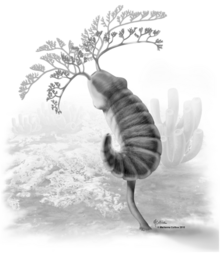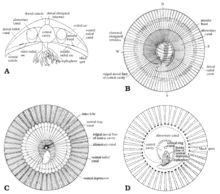| Cambroernids Temporal range: Cambrian–Devonian PreꞒ Ꞓ O S D C P T J K Pg N | |
|---|---|

| |
| Herpetogaster | |

| |
| Eldonia | |
| Scientific classification | |
| Domain: | Eukaryota |
| Kingdom: | Animalia |
| Stem group: | Ambulacraria |
| Clade: | †Cambroernida Caron, Conway Morris, & Shu, 2010 |
| Subdivisions | |
The Cambroernida are a clade of Paleozoic animals with coiled bodies and filamentous tentacles. They include a number of early to middle Paleozoic (Cambrian to Devonian) genera noted as "bizarre" or "orphan" taxa, meaning that their affinities with other animals, living or extinct, have long been uncertain. While initially defined as an "informal stem group," later work with better-preserved fossils has strengthened the argument for Cambroernida as a monophyletic clade.
Description
Cambroernids encompass three particular types of enigmatic animals first appearing in the Cambrian: Herpetogaster (the type genus), Phlogites, and the Eldonioidea. They are united by a set of common features including at least one pair of bifurcated or divided oral tentacles, and a large stomach and narrower intestine enclosed together in a clockwise-coiled sac.
Taxonomy and evolution
From left: Herpetogaster collinsi, Phlogites longus, Eldonia ludwigi

 te: tentacles, ph: pharynx, dt: digestive tract, ics: inner coiled sac, ocs: outer coiled sac, an: anus, st: stolon
te: tentacles, ph: pharynx, dt: digestive tract, ics: inner coiled sac, ocs: outer coiled sac, an: anus, st: stolon
Body coiling increased throughout this group's evolution. Herpetogaster has a segmented and clockwise-curved body attached to the substrate via a narrow and partially mobile stolon (stalk). Phlogites was even more simple, with a thick immobile stolon leading up to a tentacle-bearing calyx (cup-shaped main body), with internal gut coiling. The eldoniids (also known as eldonioids or eldonids) were diverse and disc-shaped, commonly described as "medusiform", i.e. jellyfish-shaped. Though the lifestyle of eldoniids is still debated, it can be agreed that they had a large curved stomach and no stolon.
The lack of a post-anal tail in cambroernids suggests that, contrary to long-held assumptions, this feature was not present in the common ancestor of deuterostomes. This is congruent with the significant differences between the post-anal tails of chordates and hemichordates. This and other features of cambroernids suggest that post-anal tails, gill bars, and a U-shaped gut evolved multiple times in the deuterostomes through convergence.
Segmentation, as seen in Herpetogaster, is a notable characteristic of chordates not seen in other ambulacrarians, indicating that it might be a trait of ancestral deuterostomes.
Phylogeny
Phylogenetic analysis offers strong support for Cambroernida as a clade of stem-group ambulacrarians. The following cladogram is simpllified from Li et al. 2023; only a sampling of eldonioids were included in the analysis:
| Ambulacraria |
| ||||||||||||||||||||||||||||||||||||||||
| (total group) |
Internal classification
Genera whose family placement is tentative are preceded with (?).
- Herpetogaster
- Phlogites
- Class Eldonioidea
- Family Eldoniidae
- Eldonia (=Stellostomites; =Yunnanomedusa)
- Family Rotadiscidae
- Rotadiscus (=Brzechowia)
- Pararotadiscus
- (?) Vellumbrella
- (?) Seputus
- "Paropsonemids" (informal group)
- Family Eldoniidae
Note that some authors continue to treat Stellostomites as a separate taxon.
History of identification
Previously, some cambroernids were compared to members of the broad invertebrate clade Lophotrochozoa. In particularl, they were allied with the lophophorates, a subset of lophotrochozoans bearing ciliated tentacles known as lophophores. However, this interpretation has more recently been considered unlikely relative to the deuterostome hypothesis for cambroernid origins.
References
- ^ Hagadorn & Allmon 2019
- ^ Caron et al. 2010, p. 2
- ^ Li et al. 2023
- ^ Li et al. 2023, p. 2362
- Zhu, Zhao & Chen 2002
- ^ Dzik, Yuanlong & Maoyan 1997
- ^ Lefebvre et al. 2022
- Chen, Zhu & Zhou 1995
- Caron et al. 2010, p. 7
- MacGabhann & Murray 2010
- ^ Li et al. 2023, pp. 2362–2364
- Li et al. 2023, p. 2363
- Schroeder, Paterson & Brock 2018
- Lieberman et al. 2017, p. 12
- Zhang et al. 2006 (Note: Cites the 1999 discovery publication Early Cambrian Chengjiang Fauna from Kunming Region China (Luo Hui-Lin, Hu Shi-Xie, Chen Liang-Zhong, Zhang Shi-Shan, Tau Yong-Shan), which is in Chinese and not available online)
Works cited
- Chen, Jun-yuan; Zhu, Mao-yan; Zhou, Gui-qing (1995). "The Early Cambrian medusiform metazoan Eldonia from the Chenjiang Lagerstätte" (PDF). Acta Palaeontologica Polonica. 40 (3): 213–244.
- Caron, J.; Conway Morris, S.; Shu, D.; Soares, D. (2010). Soares, Daphne (ed.). "Tentaculate fossils from the Cambrian of Canada (British Columbia) and China (Yunnan) interpreted as primitive deuterostomes". PLOS ONE. 5 (3): e9586. Bibcode:2010PLoSO...5.9586C. doi:10.1371/journal.pone.0009586. PMC 2833208. PMID 20221405.
- Dzik, Jerzy; Yuanlong, Zhao; Maoyan, Zhu (1997). "Mode of life of the Middle Cambrian eldonioid lophophorate Rotadiscus" (PDF). Palaeontology. 40 (2): 385–396.
- Hagadorn, James W.; Allmon, Warren D. (2019-01-01). "Paleobiology of a three-dimensionally preserved paropsonemid from the Devonian of New York". Palaeogeography, Palaeoclimatology, Palaeoecology. Studies in Honor of Prof. David J. Bottjer. 513: 208–214. Bibcode:2019PPP...513..208H. doi:10.1016/j.palaeo.2018.08.007. ISSN 0031-0182. S2CID 133683311.
- Lefebvre, Bertrand; Van Roy, Peter; Zamora, Samuel; Gutiérrez-Marco, Juan Carlos; Nohejlová, Martina (2022-03-31). "The Late Ordovician Tafilalt Biota, Anti-Atlas, Morocco: a high-latitude perspective on the GOBE". Geological Society, London, Special Publications. 485 (1): 5–35. Bibcode:2022GSLSP.485....5L. doi:10.1144/sp485-2022-29. ISSN 0305-8719. S2CID 247351043.
- Li, Yujing; Dunn, Frances S.; Murdock, Duncan J.E.; Guo, Jin; Rahman, Imran A.; Cong, Peiyun (May 10, 2023). "Cambrian stem-group ambulacrarians and the nature of the ancestral deuterostome". Current Biology. 33 (12): 2359–2366.e2. Bibcode:2023CBio...33E2359L. doi:10.1016/j.cub.2023.04.048. PMID 37167976. S2CID 258592223.
- Lieberman, Bruce S.; Kurkewicz, Richard; Shinogle, Heather; Kimmig, Julien; MacGabhann, Brendan Anraoi (June 6, 2017). "Disc-shaped fossils resembling porpitids or eldonids from the early Cambrian (Series 2: Stage 4) of western USA". PeerJ. 5: e3312. doi:10.7717/peerj.3312. PMC 5463991. PMID 28603667.
- MacGabhann, Breandán Anraoi; Murray, John (2010). "Non-mineralised discoidal fossils from the Ordovician Bardahessiagh Formation, Co. Tyrone, Ireland". Irish Journal of Earth Sciences. 28: 1–12. doi:10.3318/IJES.2010.28.1. hdl:10395/2407. JSTOR 25780702. S2CID 129593969.
- Schroeder, Natalie I.; Paterson, John R.; Brock, Glenn A. (2018). "Eldonioids with associated trace fossils from the lower Cambrian Emu Bay Shale Konservat-Lagerstätte of South Australia". Journal of Paleontology. 92 (1): 80–86. Bibcode:2018JPal...92...80S. doi:10.1017/jpa.2018.6. ISSN 0022-3360. S2CID 197586878.
- Zhang, Zhifei; Shu, Degan; Han, Jian; Liu, Jianni (2006). "New data on the rare Chengjiang (Lower Cambrian, South China) linguloid brachiopod Xianshanella haikouensis". Journal of Paleontology. 80 (2): 203–211. doi:10.1666/0022-3360(2006)080[0203:NDOTRC]2.0.CO;2.* Zhu, Mao-Yan; Zhao, Yuan-Long; Chen, Jun-Yuan (2002-03-01). "Revision of the Cambrian discoidal animals Stellostomites eumorphus and Pararotadiscus guizhouensis from South China". Geobios. 35 (2): 165–185. Bibcode:2002Geobi..35..165Z. doi:10.1016/S0016-6995(02)00025-6. ISSN 0016-6995.
This article related to a Cambrian animal is a stub. You can help Misplaced Pages by expanding it. |